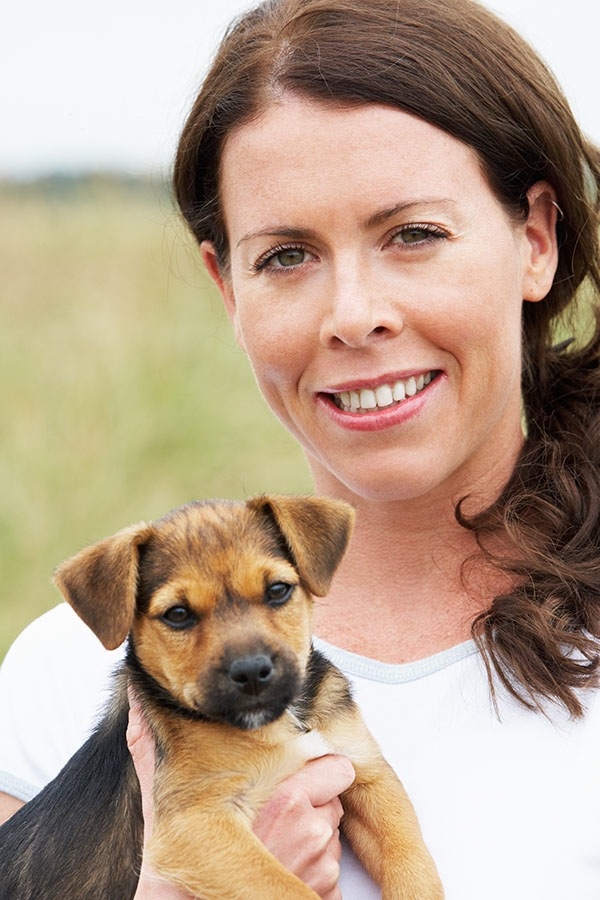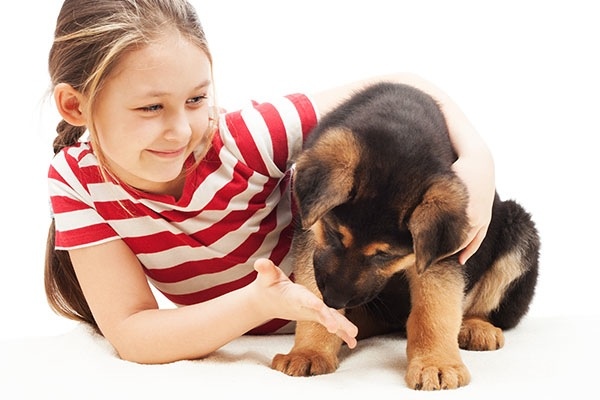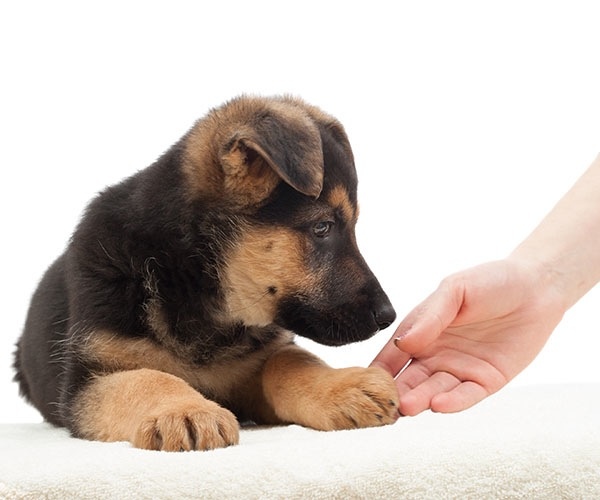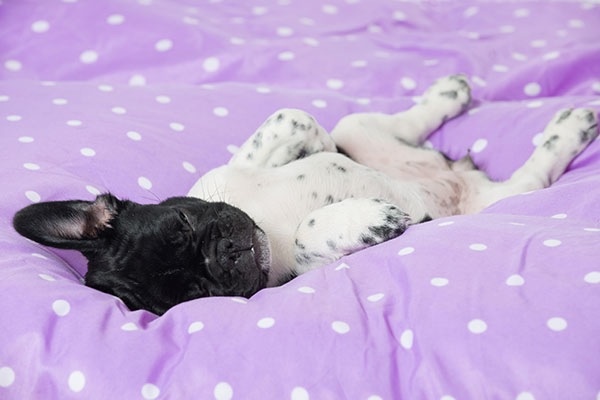Chapter 8: Socialization
There is some debate about the exact age when the socialization window for puppies closes—generally between twelve and eighteen weeks of age. What isn’t debated is the importance of the socialization period. During this time, puppies learn about the world around them, forming opinions that follow them into adulthood.
If during this time, a puppy doesn’t have positive exposure to a wide variety of people, animals, environments, surfaces, sounds, and other experiences, then he or she could become frightened of them later. For example, if a puppy doesn’t have a lot of exposure to children, and he meets a toddler when he’s a year old, he could growl at the child. Toddlers move and act differently than adults—they shriek unexpectedly, make jerky movements as they learn to walk, and like to grab things tightly. This can be very startling to a dog that is not used to toddlers, and a growl is a signal that the dog is afraid. Conversely, if a puppy is exposed in a positive manner to children before he is eighteen weeks old, he is more likely to be comfortable around children as an adult.
When people adopt a rescue dog that proves to be fearful of men, or children, or certain situations, they often think it’s because the dog had previously been abused. While that’s certainly possible, if it were the case in every situation of a fearful dog, there would be a tremendous amount of abuse going on. The more likely scenario is that the dog was not properly socialized during his critical socialization period.
For example, if a puppy is mainly raised in a backyard with other dogs, with very limited experience with people, he is very likely to love other dogs but be very wary of people. He was never around people during the critical socialization period to bond with them and learn that people can be trusted. This is why some rescue dogs get along quickly with other dogs but not people—they were more socialized with other dogs as puppies than they were people.
The socialization period is the most important time in your puppy’s life, and you have a tremendous responsibility to get it right! Skimping on properly socializing your puppy can cause major behavioral problems later. Get a calendar and chart the amount of time you have until his socialization window closes. Commit to a number of visits each week, during which you will take your puppy to different places to meet different people and animals, making it your puppy’s social calendar. Having set appointments can help you plan and stick to a schedule better.
Socialization, however, is not just taking your puppy everywhere. You must make sure that each new experience is a positive one for your puppy, watching him for any signs of fear or stress. If he has bad experiences, they will linger with him and could cause the fear or aggression you’re trying to avoid.

If a puppy spends most of his time in a backyard with other dogs, he is likely to be wary of people.
Recognizing Signs of Fear and Helping Your Puppy Cope
Throughout your socialization training, watch your puppy for signs of stress. Many people don’t even realize when their puppy is afraid. Learn the signs so that you can recognize them. Signs of stress include:
•Licking lips
•Yawning
•Turning away
•Tucking his tail
•Trying to avoid the situation
•Refusing treats
If your puppy demonstrates any of these symptoms, assess the situation. What is he concerned about? See if you can get some distance between him and what he is afraid of, or you can try to make the situation less scary for him and start clicking and treating for brave behavior.
For example, your puppy shows that he is afraid of your friend, a very tall man wearing a hat. Ask your friend to sit down so that he doesn’t appear so tall. Take your puppy farther from your friend and then click and treat him for any look or movement toward the man. Your friend should avoid eye contact and not pet your puppy if he is afraid. As your puppy gets more confident and begins to approach your friend, he can start dropping treats for your puppy and eventually hand him treats. Just take it slow, realizing that it may take more than one session for some puppies to gain confidence.
If you find that you are not making progress, remove your puppy from the situation. It’s better to limit a scary experience than push your puppy. Never force a puppy to confront his fear. For example, allowing your tall male friend to pick up your frightened puppy would be a terrible idea. Your puppy will trust you less for allowing the scary man to pick him up, and it could backfire and cause the puppy to become even more frightened of tall men, or even men in general.
Some people will try this and see their puppy frantically licking the man’s face, thinking, “He likes him! It worked!”—but this is actually an appeasement behavior. Your puppy is pleading, not showing affection. Puppy kisses aren’t always the sign of a happy puppy—you need to view them in context with the rest of his body language and demeanor.
Even the most confident puppy can find something that startles him. A bold, rambunctious puppy could be scared of the vacuum cleaner or an umbrella. As long as you are prepared and watch your puppy for signs of distress, you can help turn scary situations into better ones for socialization success.
Vet Tip
Puppy Socialization
Mary Fluke, DVM, a veterinarian at Mallard Creek Animal Hospital in Charlotte, North Carolina, warns that puppies that do not get socialized within the critical socialization period are at risk for behavior problems. “We need to immunize puppies against disease with vaccines, but we also have to immunize them against ‘the world’ with proper socialization,” Dr. Fluke says.
“I suggest a focused program of socialization to people early in the critical period by inviting people to the home for the first few weeks, then taking the puppy out into the world in the latter part of the first three months. Start vaccines by six to eight weeks and follow your vet’s advice for how often and how many doses are needed. Once the puppy has had at least two vaccinations and is ten weeks old, it’s OK to start puppy classes—with other well-cared for, healthy puppies!”
Dr. Fluke also recommends having your puppy play with older dogs more than other puppies. She explains, “When puppies play together, they can learn some very bad habits. When they interact with grown-up dogs, they learn to be polite to other dogs.”
She also agrees that your puppy’s socialization experiences should be fun for your puppy. “If you think things are getting out of hand,” she says, “bail out!”

If your puppy hasn’t had all of his vaccinations yet, take him only to places where you can carry him.
Be Social but Safe
While your puppy needs as many positive social experiences as possible before his critical socialization window closes, remember that he has not had all of his shots yet. He won’t complete his puppy series of vaccinations, including the rabies vaccine, until the end of the socialization window. This means that it’s not safe for him to walk on surfaces where sick dogs might have been, including pet stores, public parks, and your neighborhood. Dogs that are infected with distemper, parvovirus, or other diseases spread the diseases through bodily fluids. Stray dogs can carry disease because they do not get regular health care and vaccinations. So if a sick dog pees in your neighborhood and your puppy walks in that spot, he could contract the disease.
In order to keep your puppy safe, don’t take him to those places unless you are able to carry him. For a small puppy, this is relatively easy for most. Larger puppies could prove harder! You can successfully socialize your puppy safely. You just have to get creative.
Instead of taking your puppy places, bring experiences to your puppy. Have people and safe dogs come visit you. If you take your puppy to a store that allows dogs, have him ride in the cart. (Don’t forget to make the cart ride a positive experience, too!) If you have friends who have enclosed yards that have never had exposure to contagious diseases, such as parvovirus, you can take your puppy there. Note that parvovirus can survive in the environment for up to about seven months.
If your puppy does need to have paws on the ground in an area you suspect may not be disease-free, carry baby wipes with you and wipe his paws once you get him in the car or another “safe zone.”
When people meet your puppy, have them wash their hands first. If they’ve been walking in places that are suspect, have them remove their shoes when they come into your house so they don’t track in disease.
As long as you take the proper precautions, the benefits of properly socializing your puppy will greatly outweigh the chances of your puppy contracting disease. You will be preventing serious behavioral problems, such as fear and aggression, as your puppy grows up.
Trainer Tip: Exploring Different Environments
Whenever you take your puppy to a new place, bring your clicker and treats. Click and treat for exploratory behavior. Try to vary the surfaces that your puppy explores, from carpet to slick floors. Keeping in mind safety precautions, take your puppy to different homes, stores that allow pets, the veterinary office, the groomer, and more.
Meeting People
Dr. Ian Dunbar, veterinarian, behaviorist, and the founder of the Association of Professional Dog Trainers (APDT), recommends that puppies meet more than one hundred people during their socialization periods. Choose a variety of people to meet your puppy—people of different genders, ethnicities, and ages. Make sure that everyone you choose is comfortable and confident with puppies. If someone is afraid of your puppy and acts nervous, jerks his hands away, and only tentatively pets the puppy, the puppy will pick up on this, and it could frighten him, too.
Give people treats to give your puppy. Have a person present the treat in an open hand to prevent those sharp puppy teeth from chomping down on his fingers.
When you introduce your puppy to all of these different people, monitor him closely. Does he seem to be more hesitant around some types of people than others? Try giving those people extra special treats to give your puppy.
Meeting Children
Make sure that you choose children to meet your puppy who can follow your directions and who will be gentle with your puppy. Do not let him meet kids who are afraid of dogs because this could frighten the puppy, too. If you have an exuberant or large puppy, keep him on leash so you can better control him from jumping on the children and potentially hurting them.
If your puppy is in the teething stage and especially nippy, have the children drop treats on the floor for the puppy instead of handing them to him. Children have fragile skin, and you don’t want the puppy to accidentally nip fingers.
Children often love to pick up puppies, but that doesn’t mean it’s a good socialization experience. Only allow children to pick up your puppy if they are able to do so correctly, picking him up slowly and supporting his rear. Do not allow children to pick your puppy up under his front legs or tote him around like a doll. Your puppy will not feel supported and could become frightened.

Choose children who can follow directions and will be gentle socializing your puppy.
Meeting Other Dogs
Before you allow your puppy to meet another dog, you must be absolutely certain that dog is good with puppies. Not every dog likes other dogs. Even some dogs that enjoy the company of other adult dogs may not like puppies. You don’t want to find this out too late, after your puppy has been bitten or injured!
Also, some dogs like puppies but may be too exuberant to safely play with your puppy, depending on the size difference. Always check with the dog’s owner first. Ask what interactions that dog has had specifically with puppies. If you have any concerns, do not allow a greeting. Your puppy could get hurt and develop a fear of other dogs.
If you are confident that the interaction will be safe, and the dogs are enclosed in a fenced yard, it’s often best to let them meet off leash. Leash tension can increase aggression in some dogs. Stay close to the dogs and be ready to intervene if necessary.
If you need to introduce the dogs on leash, try to keep the leashes loose enough to reduce leash tension but without so much slack that the dogs could get tangled. Give the dogs room to circle each other. On leash, three-second interactions are ideal. Allow the dogs to interact for three seconds and then call them away. Assess the situation. Are the dogs eager to return to each other? Friendly? Allow another three-second introduction. Repeat several times until you are sure that they will get along, and then you can allow longer interactions.
In appropriate dog–dog play, each dog enjoys the interaction. It’s normal for one dog to be “on top” for a bit, and then for dogs to switch positions. Chasing, body slamming, jaw sparring (when the dogs have open mouths and make lots of noise clashing their muzzles together but aren’t doing any damage), tug-of-war, and chewing on each other are all typical canine games.
Different breeds have different play styles. Herding breeds generally love to chase, while sporting breeds can play pretty rough wrestle/tackle games. Some dogs do not do well with dogs that have play styles different from their own. Always watch canine play closely to ensure that everyone is having a good time. Praise them for good behavior!
If your puppy’s tail is tucked and he tries to get away from the other dog, hides under a chair or in a corner, or runs to you for safety and acts distressed, your puppy is not enjoying being with the other dog. Conversely, some puppies are too much for older dogs. If the older dog is looking distressed, take your puppy away. The older dog may not appreciate a boisterous puppy with needle teeth chomping on him!
If you already have dogs and have brought home a new puppy, the techniques for introductions still apply. You will just need to watch the dogs for extended periods of time to ensure that everyone is getting along consistently. You may find that older dogs need occasional breaks from your puppy or that your puppy needs breaks from an overattentive older dog.
Even if you do have dogs at home for your puppy to meet, don’t check off that socialization box just yet, especially if all dogs are the same breed. Make sure that your puppy gets to meet other dogs outside the home so that he learns to get along with a variety of canines.
Did You Know? Dog Parks Are Not for Puppies
Dog parks can be good places for adolescent and adult dogs to socialize, but they are terrible for puppy socialization. One bullying experience at a dog park (e.g., several dogs gang up on your puppy) can cause your puppy to be fearful toward other dogs for years, or even for life. Fearful puppies often grow up to be aggressive dogs. While some dog parks are designed well and attended by people who supervise their dogs and only bring appropriate dogs to the park, this is not the case with every park. Some people bring reactive dogs to dog parks. Others are busy on their cell phones and don’t even notice when their dogs bully other dogs. Others are not educated in canine behavior, so if their dog is a bully, they just say that it’s how he “plays.” You can’t control the environment at a dog park, so don’t expose your puppy and risk a bad experience. When your puppy grows up to be a teenager, do your research. If there is a quality dog park nearby, then you can visit without a socialization risk.
Socialization Games
Getting your puppy socialized is going to be hard work, but that doesn’t mean it can’t be fun! Socialization games will keep the task enjoyable for you, your puppy, and your friends. Here are some games to try.
Handling Games
You can ask people to participate in the handling training exercise—the same one that you will be doing with your puppy. Choose people who are comfortable with puppies and can handle yours appropriately. No grabbing! Only gentle touches. It’s good for your puppy to learn to be handled by others because your veterinarian and perhaps a groomer will need to handle him. The game will go better if you tire your puppy out a bit beforehand. Play with him, let him run in your yard, or do another activity to settle him down a bit before your friends help you with this game. Take one meal’s worth of your puppy’s kibble and divide it into separate baggies, one for each person who will participate. To each bag, add a few extra tasty treats. As each person touches the puppy on various places—his paws, ears, mouth, and tail—he or she will give the puppy a treat.
Tip: If your puppy gets too squirmy or starts biting your friends’ hands, then he may need a break. The game may be too much for him. Try to tire him out some more and then try again.

For handling games, choose people who are comfortable with puppies.
Scavenger Hunts
Come up with a scavenger hunt to complete your socialization exercises. Your puppy will get lots of treats during the hunt, but you should also reward yourself for completing it! For example, on one weekend outing, plan to:
1.Meet a stranger wearing a hat or hoodie.
2.Meet a small group of children.
3.Meet a man with a beard.
4.Meet two people wearing sunglasses.
5.Meet a person using a cane or crutches.
6.Meet a child on a skateboard.
7.See a balloon.
8.Experience a sudden noise.
9.Watch a sprinkler when it is turned on.
10.See a big truck drive by.
Bring your clicker and treats. Click and treat for brave, confident behavior. If you are actually greeting a person, he or she can give your puppy treats. If you are just watching the person go by, you can give the treats to your puppy.
Note what your puppy likes and what things concern him. For the things that make him worried or afraid, try them again on your next scavenger hunt so you can make them more positive associations for your puppy.
Circle of Friends
This game also involves other people, preferably enough to form a large circle when sitting on the ground. Divide up your puppy’s kibble into a baggie for each person. Add some tasty treats to each bag. Each person should also have a clicker.
Each person should take turns calling the puppy’s name in a friendly voice, encouraging the puppy to come to him or her. When the puppy arrives, click and treat. Take turns randomly going around the circle.
This game builds positive associations for the action of approaching people. Vary the people in the circle each time you play it so that your puppy learns to happily approach a variety of people.
Try This! Going to Kindergarten
Consider taking your puppy to a puppy kindergarten class. A good puppy kindergarten class may teach obedience exercises such as Sit, Down, and Come, but the main focus should be on socialization and handling, with education on house-training and bite inhibition. Check the curriculum before you register to make sure that it’s not just an obedience class for puppies. You can teach obedience at any age, but you can only seriously impact socialization during your puppy’s socialization period. Make sure the trainer has experience with teaching puppies and uses only positive methods.
Doggy Daycare: A Tired Puppy Isn’t Always a Good Puppy
Doggy daycare has a lot of appeal. Your puppy will get to play with other dogs, won’t have to be completely alone during the day, and comes home tired. While some doggy daycares are run by professionals in canine behavior who closely supervise all interactions, many are not. Some are just as detrimental to your puppy as dog parks.
Some doggy daycares let all of the puppies just run loose together, with little supervision or understanding of how the interactions can affect young puppies. If a group of other puppies or dogs gang up on your puppy, it could cause him to become fearful around other dogs. Or your puppy could be one that learns that picking on other puppies is fun and become a bully himself.
If you are interested in taking your puppy to a doggy daycare, do your research. Interview each staff member responsible for supervising your puppy and ask about their background in canine behavior. “I’ve had puppies all my life” is not an acceptable answer! Ask them to describe the signs that a puppy is stressed, how they determine when to separate dogs, and what they do when puppies act inappropriately. Do they use positive methods?
Observe the daycare on random days and times to see what the place is like. Is it clean? Do they separate large and small dogs for interaction?
If you try a daycare, observe your puppy, knowing that signs of problems may not show up right away. Your puppy may be very tired and sleep when he gets home, which you’ll probably like because it will give you a break! Just know that he could be sleeping because he had a stressful day rather than a fun day of exercise.
Do you notice your puppy shying away from other dogs or lunging at them, perhaps growling? These are signs that his dog interactions at daycare may not be healthy ones for proper socialization. He could be learning bad things instead of good things. A doggy daycare may be better for your puppy after he has completed his socialization period and already has established positive associations with other dogs.

Doggy daycares can be stressful for puppies. Your pup may be sleeping because he had a stressful day, not because he had a fun day full of exercise.
When the Window Closes, Open the Door
Cramming so much socialization into your puppy’s early weeks can be a challenge, but one you can definitely accomplish. Just because that window closes, however, doesn’t mean that you can stop socializing your puppy. You definitely need to continue the process, but you don’t have to be on such an intensive schedule.
People who socialize their puppies very well early on but then stop once their puppies hit adolescence often find that their dogs develop problems in adulthood. They may end up fearful of certain types of people, or the veterinarian’s office, or other dogs. So don’t quit while you’re ahead! Keep up the scavenger hunts, meeting new people, and other socialization activities so that your puppy grows up to be a confident, social adult dog. It will actually be easier for you once your puppy has had all of his vaccinations. You will be able to take him more places safely.